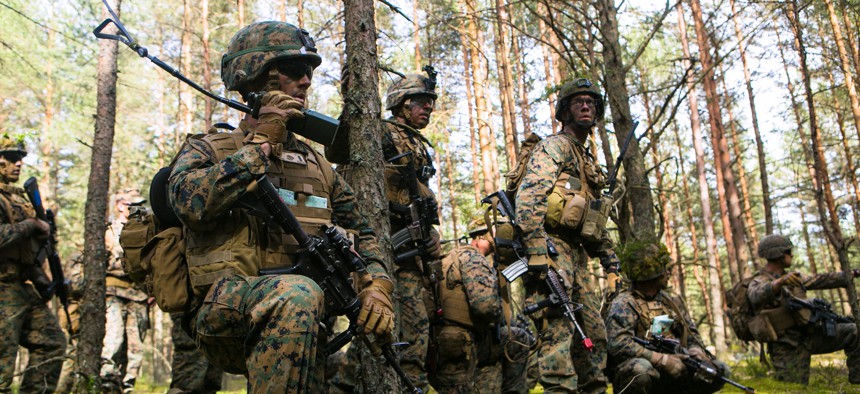
Lithuanian forces are teamed with U.S. Marines from the Black Sea Rotational Force during Exercise Saber Strike at the Pabrade Training Area, Lithuania, June 9, 2015. U.S. Marine Corps
What’s Missing as NATO Rearms Its Eastern Flank? Diplomacy
An arms buildup alone won’t keep the Baltics safe, but a parallel Cold War-style diplomatic track just might.
From a military standpoint, Western planners’ biggest headache is the defense of the Baltic states, located at the edge of NATO territory and hopelessly outnumbered by Russian troops. Indeed, the need to deter Russia will top the agenda when alliance leaders meet next month in Warsaw. But as they contemplate what military means might stop a swift, Crimea-type land grab, they should also review what they know about Moscow’s beliefs and motivations — and choose a path that might defuse, rather than elevate, regional tensions.
NATO’s fears are not unfounded. In Ukraine, Moscow achieved surprising success with unorthodox tactics that included the use of “voluntary battalions” and unidentified troops. President Putin has made it clear that Russia sees itself as the protective power for all Russians. Theoretically, this also includes the large Russian minorities in Estonia and Latvia.
Thus, the alliance is currently doing what can be expected from a collective defensive organization: it is ramping up defenses. In addition to the decisions at the last summit in Wales, Washington is sending a continually rotating brigade (about 5,000 men) to Eastern Europe. Furthermore, NATO is planning to station a multinational battalion in each of the Baltic States and Poland (altogether about 4,000 men). Romania recently reported the completion of a part of the European ballistic missile defense system. NATO is thus on track to better defend its easternmost allies.
But alliance leaders need a better approach, for even the planned measures are inadequate to mount a military defense. A recent RAND study found that available troops could hold off a Russian attack for a maximum of three days. For serious resistance, about 35,000 soldiers would be needed — and this imbalance is about to get worse. Rushing ahead of the anticipated Warsaw decisions, Russian Minister of Defense Sergey Shoygu recently announced the stationing of three new divisions (up to 30,000 men) on Russia’s western and southern borders.
Shoygu’s reaction points to the central problem with NATO’s current approach. Although alliance leaders believe they are shifting their forces in purely defensive efforts — and in particular, to minimize vulnerability to a second use of Putin’s “Crimea tactic” — that is not how Moscow sees the situation.
In fact, Russia has accepted the expansion of NATO, however reluctantly. Moscow is also clear-eyed about the ultimate consequences of an attack on an alliance member: war, and possibly with nuclear weapons. What Russia does not accept is further expansion into the post-Soviet space. To Moscow, therefore, NATO’s activism looks like hysteria and a pretext for an offensive rearmament.
The combination of fundamental, contradictory views and the imbalance in military capabilities does not augur well. It seems as if both sides are steering towards a regional security dilemma. Because one side feels uncertain, it arms itself. The other side misunderstands the intention and follows suit. A regional arms race threatens. It’s Cold War déjà vu all over.
To prevent such a scenario and, in the absence of a fundamentally new approach, the Warsaw meeting should lead NATO back to a Cold War strategy that mixes deterrence and cooperation. What became known in the 1960s as the Harmel Doctrine – that is, the combination of stronger defense and the offer of dialogue with the Soviets – was ultimately implemented in NATO’s dual-track decision of 1979. Today, NATO needs a new dual-track strategy adapted to 21st-century needs.
The formula could be as follows: Dialogue comes before any additional military build-up (on top of the Warsaw decisions). A concrete dialogue offer to Russia should aim at clearly defined consultations with a concrete deadline and a realistically approachable goal. The aim would be a reciprocal and verifiable conventional arms control regime for the region, limiting conventional forces and military equipment on both sides of the NATO-Russian border and providing for much-needed transparency about military maneuvers.
The advantages are obvious. Rather than letting itself be pulled unchecked into a renewed arms race, the Alliance would – at least temporarily – give priority to diplomacy. Thereby, the quite divergent positions between the classic proponents of deterring Russia (above all Poland, the Baltics, Romania and, to some extent, the United States) and the proponents of a more cooperative approach (particularly Germany) could be better reconciled.
Furthermore, this would offer the opportunity of an urgently needed military dialogue with Moscow. Should Russia reject or undermine the discussions, NATO could always still deploy additional forces – it wouldn’t even have to take the international blame for its allegedly “aggressive” policy. More likely Moscow would be viewed as the main spoiler in the game. Even if consultations do not yield an immediate outcome, allies could still continue the dialogue with Moscow in the hope that more favorable conditions might emerge in Russia.
The proponents of deterrence are right: The Kremlin must be shown the limits. But deterrence alone is simply not enough. In order to better gauge Russia’s intentions and prevent a costly decade of mutual rearmament, the alliance must re-discover diplomacy — starting in Warsaw.
NEXT STORY: The B-21 Bomber Should Be Unmanned on Day 1



